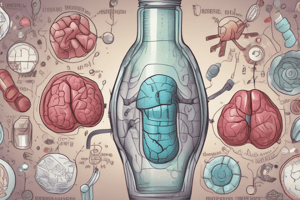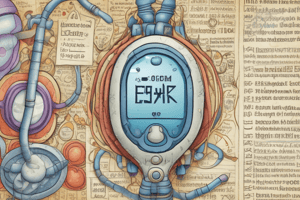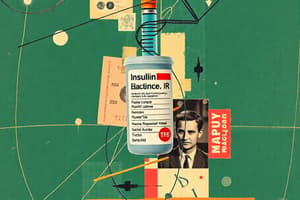Podcast
Questions and Answers
What is the primary function of insulin in the body?
What is the primary function of insulin in the body?
- To promote protein synthesis
- To stimulate the production of red blood cells
- To facilitate glucose uptake by cells (correct)
- To regulate blood pressure
Which type of diabetes is characterized by absolute insulin deficiency due to autoimmune destruction of pancreatic beta cells?
Which type of diabetes is characterized by absolute insulin deficiency due to autoimmune destruction of pancreatic beta cells?
- Type 2 Diabetes
- Type 1 Diabetes (correct)
- Prediabetes
- Gestational Diabetes
Type 2 diabetes is characterized by an inability of the cells to respond properly to insulin, a condition known as insulin resistance.
Type 2 diabetes is characterized by an inability of the cells to respond properly to insulin, a condition known as insulin resistance.
True (A)
Which of the following is NOT a common symptom of diabetes?
Which of the following is NOT a common symptom of diabetes?
Which of the following is a long-term complication of diabetes?
Which of the following is a long-term complication of diabetes?
Early diagnosis and management of diabetes are crucial to minimize long-term complications.
Early diagnosis and management of diabetes are crucial to minimize long-term complications.
What is the primary goal of pharmacologic therapies for diabetes?
What is the primary goal of pharmacologic therapies for diabetes?
Which oral hypoglycemic agent is often the first-line therapy for Type 2 diabetes?
Which oral hypoglycemic agent is often the first-line therapy for Type 2 diabetes?
How do sulfonylureas work to lower blood glucose levels?
How do sulfonylureas work to lower blood glucose levels?
What is the mechanism of action of thiazolidinediones?
What is the mechanism of action of thiazolidinediones?
Which class of oral hypoglycemic agents acts by increasing incretin hormone levels?
Which class of oral hypoglycemic agents acts by increasing incretin hormone levels?
What is the primary effect of SGLT2 inhibitors on blood glucose regulation?
What is the primary effect of SGLT2 inhibitors on blood glucose regulation?
GLP-1 receptor agonists are synthetic versions of a natural hormone that promotes insulin secretion and reduces glucagon release.
GLP-1 receptor agonists are synthetic versions of a natural hormone that promotes insulin secretion and reduces glucagon release.
Which type of insulin preparation is typically used before meals?
Which type of insulin preparation is typically used before meals?
What are the main differences between rapid-acting, short-acting, intermediate-acting, and long-acting insulin?
What are the main differences between rapid-acting, short-acting, intermediate-acting, and long-acting insulin?
Insulin can be administered via subcutaneous injections or continuous subcutaneous insulin infusion using an insulin pump.
Insulin can be administered via subcutaneous injections or continuous subcutaneous insulin infusion using an insulin pump.
Which of the following is a key factor to consider when selecting a diabetes medication?
Which of the following is a key factor to consider when selecting a diabetes medication?
Patient education on proper medication administration, blood glucose monitoring, and dietary management is crucial for therapeutic success.
Patient education on proper medication administration, blood glucose monitoring, and dietary management is crucial for therapeutic success.
Adherence to treatment plans is essential in preventing complications of diabetes.
Adherence to treatment plans is essential in preventing complications of diabetes.
Flashcards
Diabetes Mellitus (DM)
Diabetes Mellitus (DM)
Metabolic disorder with high blood sugar due to insulin problems.
Insulin's function
Insulin's function
Facilitates glucose entry into cells, preventing high blood sugar.
Type 1 DM
Type 1 DM
Autoimmune disease causing complete insulin shortage from pancreas.
Type 2 DM
Type 2 DM
Signup and view all the flashcards
Gestational DM
Gestational DM
Signup and view all the flashcards
DM Symptoms
DM Symptoms
Signup and view all the flashcards
DM Complications
DM Complications
Signup and view all the flashcards
Oral hypoglycemic agents
Oral hypoglycemic agents
Signup and view all the flashcards
Metformin
Metformin
Signup and view all the flashcards
Sulfonylureas
Sulfonylureas
Signup and view all the flashcards
Thiazolidinediones
Thiazolidinediones
Signup and view all the flashcards
DPP-4 Inhibitors
DPP-4 Inhibitors
Signup and view all the flashcards
SGLT2 Inhibitors
SGLT2 Inhibitors
Signup and view all the flashcards
GLP-1 Receptor Agonists
GLP-1 Receptor Agonists
Signup and view all the flashcards
Insulin Therapy
Insulin Therapy
Signup and view all the flashcards
Insulin preparations
Insulin preparations
Signup and view all the flashcards
Insulin administration
Insulin administration
Signup and view all the flashcards
Patient Education
Patient Education
Signup and view all the flashcards
Treatment Adherence
Treatment Adherence
Signup and view all the flashcards
Blood Glucose Monitoring
Blood Glucose Monitoring
Signup and view all the flashcards
Drug Selection Considerations
Drug Selection Considerations
Signup and view all the flashcards
Rapid-acting insulin
Rapid-acting insulin
Signup and view all the flashcards
Short-acting insulin
Short-acting insulin
Signup and view all the flashcards
Intermediate-acting insulin
Intermediate-acting insulin
Signup and view all the flashcards
Long-acting insulin
Long-acting insulin
Signup and view all the flashcards
Combination Insulins
Combination Insulins
Signup and view all the flashcards
Study Notes
Diabetes Mellitus
- Diabetes mellitus (DM) is a metabolic disorder characterized by hyperglycemia, resulting from defects in insulin secretion, insulin action, or both.
- The primary function of insulin is to facilitate glucose uptake by cells, preventing hyperglycemia.
- Type 1 DM is characterized by absolute insulin deficiency due to autoimmune destruction of pancreatic beta cells.
- Type 2 DM is characterized by insulin resistance coupled with relative insulin deficiency. Environmental factors and genetic predisposition play a role.
- Gestational DM is hyperglycemia that develops during pregnancy.
- Symptoms of DM often include excessive thirst, frequent urination, unexplained weight loss, slow-healing sores, blurred vision, and fatigue.
- Complications of DM include cardiovascular disease, nephropathy, retinopathy, neuropathy, and peripheral vascular disease. Early diagnosis and management are crucial to minimize long-term complications.
Pharmacology in Diabetes Management
- Pharmacologic therapies for DM aim to improve insulin secretion, enhance insulin sensitivity, or reduce glucose absorption.
- Oral hypoglycemic agents, such as metformin, sulfonylureas, thiazolidinediones, DPP-4 inhibitors, SGLT2 inhibitors, and GLP-1 receptor agonists, are commonly used for Type 2 DM.
- Metformin, a biguanide, is often the first-line therapy for Type 2 DM. It works by reducing hepatic glucose production and improving insulin sensitivity in peripheral tissues.
- Sulfonylureas stimulate insulin secretion from pancreatic beta cells.
- Thiazolidinediones increase insulin sensitivity in peripheral tissues.
- DPP-4 inhibitors increase incretin hormone levels which stimulate insulin secretion.
- SGLT2 inhibitors reduce glucose reabsorption by the kidneys.
- GLP-1 receptor agonists mimic the action of GLP-1, promoting insulin secretion and reducing glucagon release.
- Insulin therapy is necessary for Type 1 DM and sometimes for advanced Type 2 DM, where oral agents are insufficient.
- Various insulin preparations exist, differentiated by their onset, peak, and duration of action. This allows for tailored dosing to manage blood glucose levels effectively.
- Insulin administration routes include subcutaneous injections and continuous subcutaneous insulin infusion (insulin pumps).
- Patient education on proper medication administration, blood glucose monitoring, and dietary management is essential for therapeutic success.
- Adherence to treatment plans is critical in preventing complications.
- Careful monitoring of blood glucose levels, along with regular evaluation for potential adverse effects and complications, is crucial for effective and safe pharmaceutical treatment of diabetes.
Drug Classes and Mechanisms
- Biguanides (Metformin): Reduce hepatic glucose production, improve peripheral insulin sensitivity.
- Sulfonylureas: Stimulate insulin secretion from pancreatic beta cells.
- Thiazolidinediones: Increase peripheral insulin sensitivity.
- DPP-4 Inhibitors: Increase incretin hormone levels, stimulating insulin secretion and reducing glucagon release.
- SGLT2 Inhibitors: Reduce glucose reabsorption in the kidneys.
- GLP-1 Receptor Agonists: Mimic the action of GLP-1 promoting insulin secretion and reducing glucagon release.
Insulin Types
- Rapid-acting: Rapid absorption, short duration, used before meals.
- Short-acting: Intermediate duration, used before meals.
- Intermediate-acting: Slower absorption, longer duration, may be used once or twice daily.
- Long-acting: Very slow absorption, very long duration, used once daily.
- Combination insulins: Mixes of different types of insulin.
Considerations in Drug Selection
- Patient's age and comorbidities.
- Severity of hyperglycemia.
- Cost-effectiveness.
- Potential drug interactions.
- Patient preference and lifestyle factors.
- Individual response to different medications.
- Potential side effects of the medications.
Studying That Suits You
Use AI to generate personalized quizzes and flashcards to suit your learning preferences.
Description
Explore the key aspects of diabetes mellitus, including its types, symptoms, and complications. Understand the role of insulin and pharmacological interventions in managing this prevalent metabolic disorder. Take this quiz to test your knowledge and improve your understanding of diabetes management.




